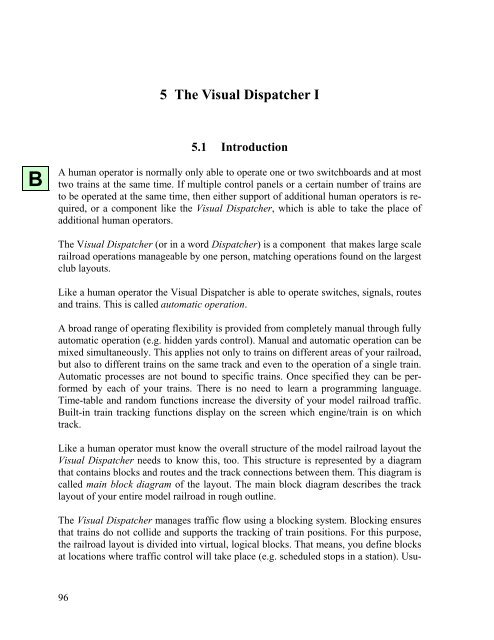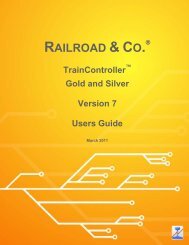Download - Freiwald Software
Download - Freiwald Software
Download - Freiwald Software
You also want an ePaper? Increase the reach of your titles
YUMPU automatically turns print PDFs into web optimized ePapers that Google loves.
B<br />
96<br />
5 The Visual Dispatcher I<br />
5.1 Introduction<br />
A human operator is normally only able to operate one or two switchboards and at most<br />
two trains at the same time. If multiple control panels or a certain number of trains are<br />
to be operated at the same time, then either support of additional human operators is required,<br />
or a component like the Visual Dispatcher, which is able to take the place of<br />
additional human operators.<br />
The Visual Dispatcher (or in a word Dispatcher) is a component that makes large scale<br />
railroad operations manageable by one person, matching operations found on the largest<br />
club layouts.<br />
Like a human operator the Visual Dispatcher is able to operate switches, signals, routes<br />
and trains. This is called automatic operation.<br />
A broad range of operating flexibility is provided from completely manual through fully<br />
automatic operation (e.g. hidden yards control). Manual and automatic operation can be<br />
mixed simultaneously. This applies not only to trains on different areas of your railroad,<br />
but also to different trains on the same track and even to the operation of a single train.<br />
Automatic processes are not bound to specific trains. Once specified they can be performed<br />
by each of your trains. There is no need to learn a programming language.<br />
Time-table and random functions increase the diversity of your model railroad traffic.<br />
Built-in train tracking functions display on the screen which engine/train is on which<br />
track.<br />
Like a human operator must know the overall structure of the model railroad layout the<br />
Visual Dispatcher needs to know this, too. This structure is represented by a diagram<br />
that contains blocks and routes and the track connections between them. This diagram is<br />
called main block diagram of the layout. The main block diagram describes the track<br />
layout of your entire model railroad in rough outline.<br />
The Visual Dispatcher manages traffic flow using a blocking system. Blocking ensures<br />
that trains do not collide and supports the tracking of train positions. For this purpose,<br />
the railroad layout is divided into virtual, logical blocks. That means, you define blocks<br />
at locations where traffic control will take place (e.g. scheduled stops in a station). Usu-










